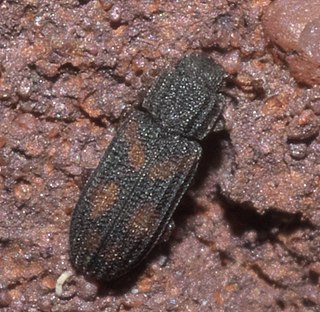
Convolvulaceae, commonly called the bindweeds or morning glories, is a family of about 60 genera and more than 1,650 species. These species are primarily herbaceous vines, but also include trees, shrubs and herbs. The tubers of several species are edible, the best known of which is the sweet potato.

Marsilea is a genus of approximately 65 species of aquatic ferns of the family Marsileaceae. The name honours Italian naturalist Luigi Ferdinando Marsili (1656–1730).
Cleopatra exarata is a species of freshwater snails with an operculum, aquatic gastropod molluscs in the family Paludomidae.

Agrostis exarata is a species of grass known by the common names spike bentgrass, spike bent, Pacific bentgrass, and spike redtop. It is native to western North America from Texas to the Aleutian Islands.

Cellana exarata, common name the black-foot ʻopihi and Hawaiian blackfoot is a species of edible true limpet, a marine gastropod mollusc in the family Nacellidae, one of the families of true limpets. ‘Opihi are significant in Hawaiian history where they have had many uses such as food, tools, and jewelry. They are known as a "fish of death".

Menestho is a genus of very small sea snails, pyramidellid gastropod mollusks, or micromollusks.

Propebela exarata is a species of sea snail, a marine gastropod mollusk in the family Mangeliidae.
Onoba exarata is a species of minute sea snail, a marine gastropod mollusk or micromollusk in the family Rissoidae.

Bullacta exarata, common name the Korean mud snail, is a species of a sea snail or bubble snail, a marine gastropod mollusc in the family Haminoeidae, the bubble snails.
Anthia tatumana is a species of ground beetle in the subfamily Anthiinae. It was described by the zoologist Adam White in 1846.

Exarata is a group of plants described as a genus in 1992.

Bitoma is a genus of cylindrical bark beetles in the family Zopheridae. There are about 15 described species in Bitoma.

Synchitini is a tribe of cylindrical bark beetles in the family Zopheridae. There are about 19 genera and at least 40 described species in Synchitini.

Bitoma quadriguttata is a species of cylindrical bark beetle in the family Zopheridae. It is found in North America.
Bitoma vittata is a species of cylindrical bark beetle in the family Zopheridae. It is found in North America.

Bitoma crenata is a species of cylindrical bark beetle in the family Zopheridae. It is found in North America and Europe.
Bitoma sulcata is a species of cylindrical bark beetle in the family Zopheridae. It is found in Central America and North America.
Amara exarata is a species of seed-eating ground beetle in the family Carabidae. It is found in North America.
Asterosmilia is a genus of cnidarians belonging to the family Caryophylliidae.
Myocalandra exarata, is a species of weevil found in India, Sri Lanka, Malay Peninsula, Philippines, New Caledonia, Madagascar, Seychelles, Mauritius and Marianas Islands.










